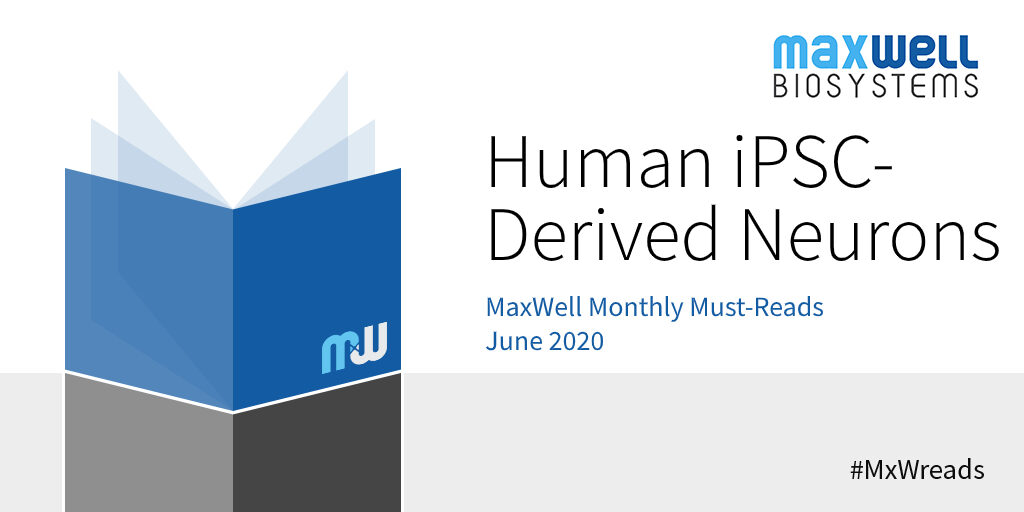We have already published five editions of MaxWell Monthly Must-Reads this year. In the first four, we mainly highlighted scientific topics. In January we focused on Axons, in February on Retina and in March we picked Organoids as our main topic. Furthermore, during times of COVID-19 in April, we highlighted Neurons and Viruses! Last month, we complemented these topics by. providing you with five key articles related to Spike Sorting
One week before the start of ISSCR 2020, we are publishing a new edition of our monthly blog. For this sixth edition of our Monthly Must-Reads we have decided to highlight Human iPSC-Derived Neurons. In recent years the popularity of iPSC-Derived Neurons has surged and gained momentum. In the subsequent section you can find the paper we believed should be highlighted and four other educational articles. For this month we decided to highlight the article Ghatak et al. concerning Alzheimer hiPSC models!
NitroSynapsin ameliorates hypersynchronous neural network activity in Alzheimer hiPSC models.
by Swagata Ghatak, Nima Dolatabadi, Richard Gao, Yin Wu, Henry Scott, Dorit Trudler, Abdullah Sultan, Rajesh Ambasudhan, Tomohiro Nakamura, Eliezer Masliah, Maria Talantova, Bradley Voytek, Stuart A. Lipton. Molecular Psychiatry . May 2020.
Alzheimer’s disease (AD) is an irreversible, progressive brain disorder that results in cognitive dysfunction. While it is necessary to test potential AD therapies in animal models, the obtained results might be less relevant than previously thought. In this month’s featured article Ghatak and co-authors use human (h)iPSC-derived 2D cortical neuronal cultures to access how NitroSynapsin affects the hyperactivity of neuronal networks characteristic of AD. They compare hiPSCs bearing familial AD mutations versus their wild-type (WT) isogenic controls, using multielectrode array (MEA), calcium imaging and whole cell patch clamp recordings. The authors conclude that NitroSynapsin abrogates hyperexcitability and rebalances network activity. This study highlights the emerging potential of using hiPSC’s for screening drugs in central nervous system disorders.
Read the paper here.
Besides the above-mentioned paper, four other publications that are highly relevant to the topic of Human iPSC-Derived Neurons are found below:
- iPSC modeling of young-onset Parkinson’s disease reveals a molecular signature of disease and novel therapeutic candidates.
by Alexander Laperle, Samuel Sances, Nur Yucer, Victoria Dardov, Veronica Garcia, Ritchie Ho, Aaron Fulton, Michelle Jones, Kristina Roxas, Pablo Avalos, Dyla West, Maria Banuelos, Z. Shu, Ramachandran Murali, Nigel Maidment, Jennifer Van Eyk, Michele Tagliati and Clive Svendsen. Nature Medicine. January 2020.
Read the paper here. - SHP2 mutations induce precocious gliogenesis of Noonan syndrome-derived iPSCs during neural development in vitro.
by Younghee Ju, Jun Sung Park, Daejeong Kim, Bumsoo Kim, Jeong Ho Lee, Yoonkey Nam, Han-Wook Yoo, Beom Hee Lee, Yong-Mahn Han. Stem Cell Research & Therapy volume. June 2020.
Read the paper here. - Synergistic effects of common schizophrenia risk variants.
by Nadine Schrode, Seok-Man Ho, Kazuhiko Yamamuro, Amanda Dobbyn, Laura Huckins, Marliette R. Matos, Esther Cheng, P. J. Michael Deans, Erin Flaherty, Natalie Barretto, Aaron Topol, Khaled Alganem, Sonya Abadali, James Gregory, Emily Hoelzli, Hemali Phatnani, Vineeta Singh, Deeptha Girish, Bruce Aronow, Robert Mccullumsmith, Gabriel E. Hoffman, Eli A. Stahl, Hirofumi Morishita, Pamela Sklar and Kristen J. Brennand. Nature Genetics volume. September 2019.
Read the paper here. - Human autologous iPSC–derived dopaminergic progenitors restore motor function in Parkinson’s disease models.
by Bin Song, Young Cha, Sanghyeok Ko, Jeha Jeon, Nayeon Lee, Hyemyung Seo, Kyung-Joon Park, In-Hee Lee, Claudia Lopes, Melissa Feitosa, María José Luna, Jin Hyuk Jung, Jisun Kim, Dabin Hwang, Bruce M. Cohen, Martin H. Teicher, Pierre Leblanc, Bob S. Carter, Jeffrey H. Kordower, Vadim Y. Bolshakov, Sek Won Kong, Jeffrey S. Schweitzer and Kwang-Soo Kim. The Journal of Clinical Investigation. November 2019.
Read the paper here.
 English
English



